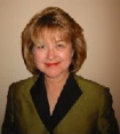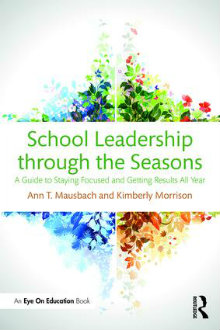School Leadership through the Seasons
School Leadership through the Seasons: A Guide to Staying Focused and Getting Results All Year
By Ann T. Mausbach and Kimberly Morrison
(Routledge/Eye On Education Book, 2016 – Learn more)

The co-authors of School Leadership through the Seasons are well qualified. One was a principal and the other a professor, and both were administrators at the district level. They begin by quoting current research on change: “Changing behavior helps to change thinking (Sinek, 2015).” Because of the title, I wanted to read this book, anticipating I’d find lists of things to do each week or month of the year.

So when an educator becomes a new principal they know that there is much more to be done than to write a school improvement plan and to do daily walk-throughs. When the rubber meets the road in the beginning of the year, there are usually a few more teachers to hire, class size configurations and adjustments to be made.
There are also ESL and special needs programs and IEP’s to be implemented, new volunteers to train, a separate safety plan to write, student councils to start, PTA demands and needs, parent orientations, discipline assemblies, transportation considerations, ordered materials inventories, and a host of other demands, not to mention (in many states) union constraints on what the administrator can and cannot do.
The charts, such as Table 1.1.,“Overview of ‘Have to Dos’ and Leader Moves” are useful, just incomplete. Although they warn that one person cannot do it alone and the seasonal chart is separated into “Principal Moves” and “Central Office Moves” (provide training and coaching to principals) with a list for Fall, in reality things often don’t get going until winter because of the initial concerns I ticked off above.
Advice to district leaders to “Provide Training to Principals” is good advice but consists of many steps and doesn’t take into consideration that principals’ backgrounds and experience may be very different.
Change takes time
I don’t mean to suggest that schools should not structure change – or that most change hasn’t been largely “tinkering” – and that the more schools change the more they seem to stay the same. But positive, lasting change takes time, and gone are the days when principals and administrators stick around for years in the same job.
The authors agree that everyone has to be working together and that there has to be “buy-in” and trust to change. But how exactly do you get that buy-in and trust, especially if you are new and there’s been a history and culture in the district that you don’t even know about? Principals could surely use some in-depth advice about that.
The authors do recognize that there might be, for instance, “misalignment” of school improvement processes and say actions must “interosculate” in order to get maximum results. They also use words like “consociate” and “simplexity” – words that are confusing and not generally used by educators I know. As a result, the book reads like a textbook. I prefer more user-friendly language.
They also acknowledge that “One of the reasons why being a school administrator is such hard work is because it can feel like an endless game of whack-a-mole.” Their answer to this is simply to say “no.” In a day and age when compliance to standards is expected and demanded, especially if a school is “out of compliance,” I don’t think “no” will go over too well.
In the example of improving a reading program, again, it seems it’s the principal who has determined that certain strategies were not in place and has “observed in every classroom every week and provided feedback via a weekly blog.” This seems like the principal is doing most of the work, even though the authors claim they believe in teacher collaboration.
The book needs more “how”
I do agree with many of the suggestions in the book, such as principal meetings should be redesigned to focus on professional learning. In general, the “what to do” is here, but the “how” is missing. There are sample schedules for a principal’s day, but in my experience, few principals leave the building at 5:00 or 6:00 p.m. and in my case the teacher’s union did not allow for working lunches with teachers. This book would have been more useful if key constraints were thought out beforehand and addressed.
I believe the successful schools are already using the processes described here: vision statements, backwards planning, collaboration and more. The schools that aren’t addressing standards or moving forward in a positive direction are most likely not going to be convinced to do so by reading this book.
Mary Langer Thompson is a retired school principal and former English teacher. She received her Ed.D. from University of California, Los Angeles and lives in southern California in the high desert. Because of her school and community work teaching memoir and poetry, she recently was honored as a “Woman of Distinction” by her Delta Kappa Gamma, Iota Xi chapter. Her award-winning children’s book, How the Blue-Tongued Skink Got His Blue Tongue, was recently released by Another Think Coming Press and is available in both English and Spanish.

































